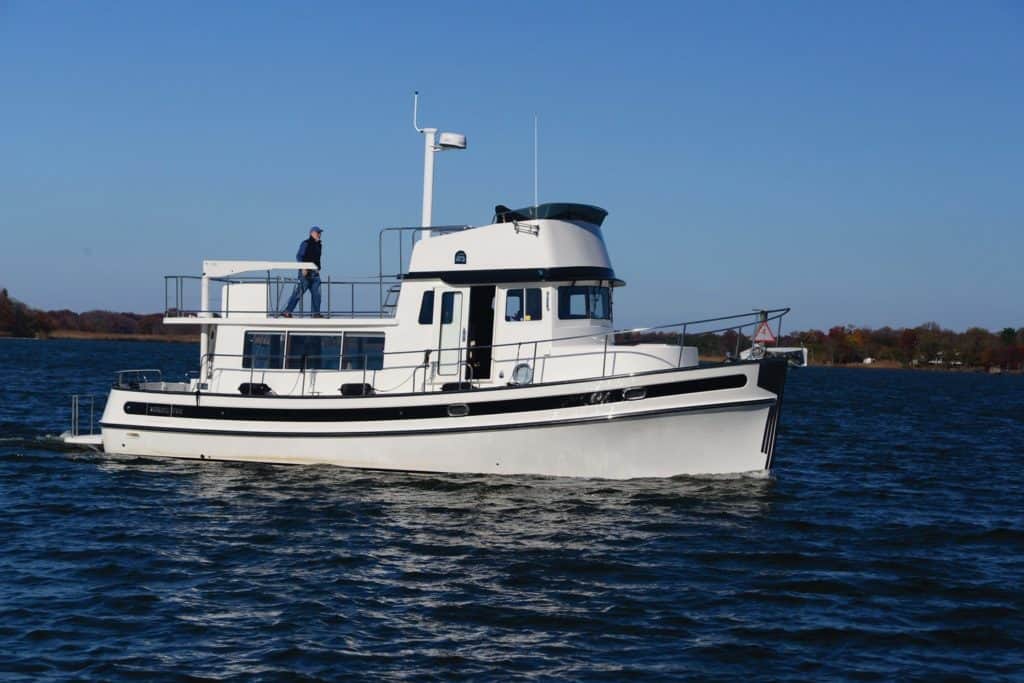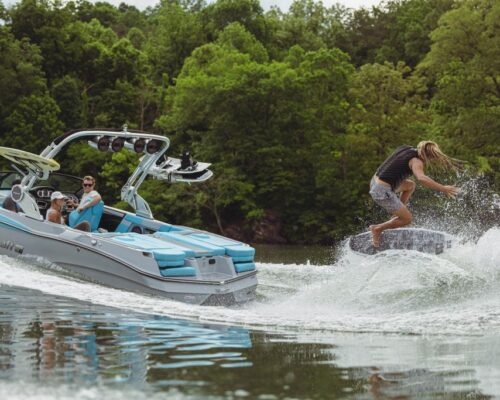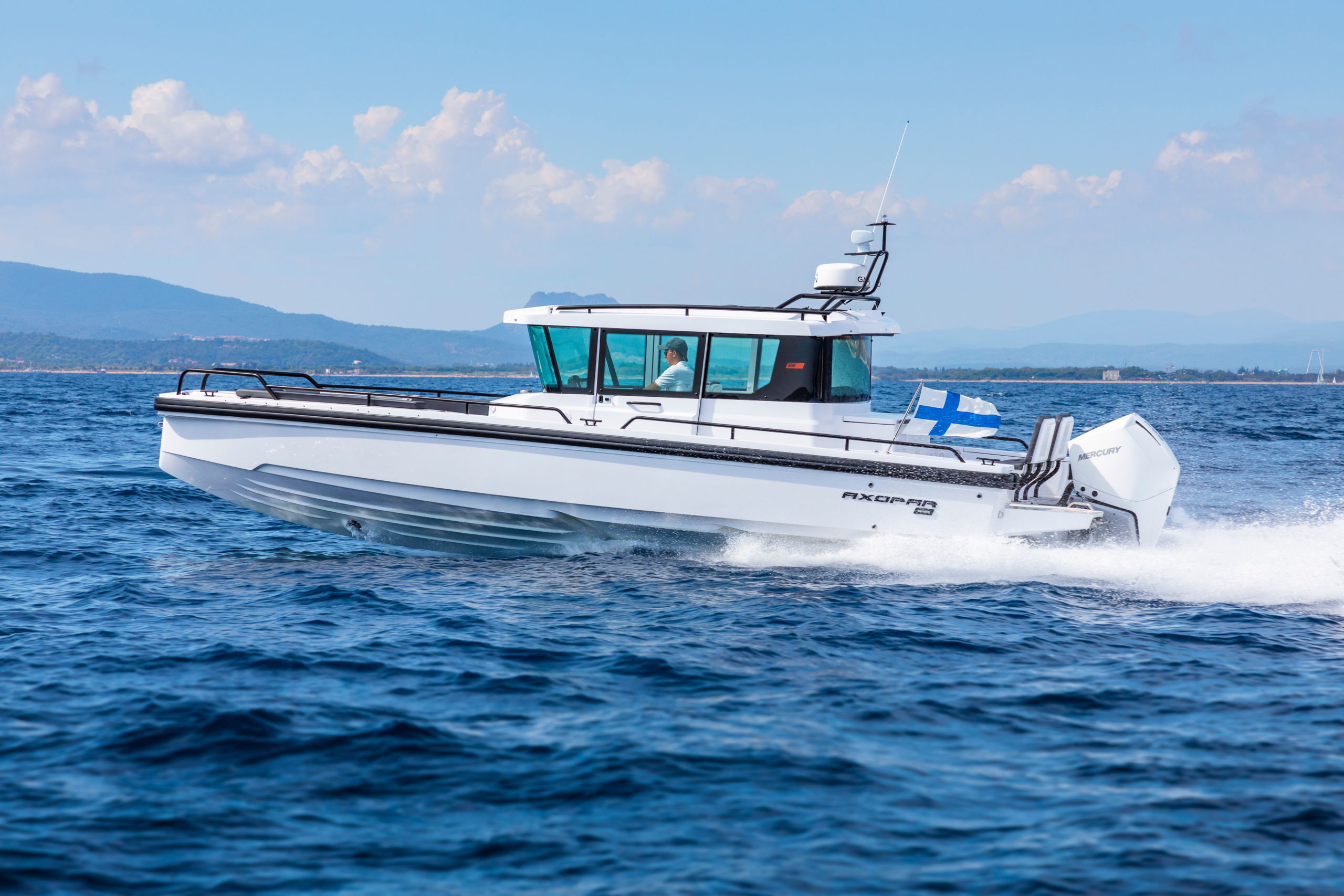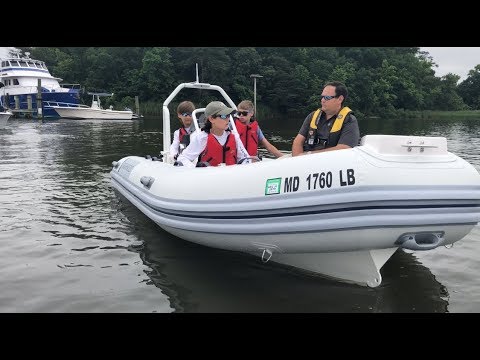Nordic Tug 44
LOA: 44′ 8″
LWL: 40′ 2″
Beam: 13′ 10″
Draft: 4′ 7″
Air Draft: 14′ Displacement: 31,400 lb (dry)
Water:200 gal
Fuel:640 gal
www.nordictugs.com
Tugboat Love. Where does it come from? For children, it’s a compact, stable, unsinkable bathtub toy and an immortal illustrated storybook, Hardie Gramatky’s Little Toot, which was G.P. Putnam’s Sons first children’s book, published in 1939 and still in print. For grownups, it’s the beauty of form following function—a seaworthy hull carrying the split-level layout of pilothouse over cabin forward with mid-level saloon aft that adapts as well for extended living aboard as it does for long-range commerical towing.
Nordic Tugs were born of the 1979 gas crisis. Jerry Husted, the new owner of a Puget Sound-based builder of cruising sailboats, began thinking about a fuel-efficient powerboat and, remembering Little Toot, hit on the idea of a cruising tug. His naval architect, Lynn Senour, worked out a hybrid hull form that moved efficiently at displacement speeds of six to eight knots, but with more throttle, lifted to semi-planing attitude to reach speeds in the mid-teens with an economical single diesel. The original Nordic Tug 26 was the hit of the 1980 Seattle Boat Show, launching the company that, 37 years later, offers six models from the original 26-footer to a commodious 54-footer, which explore waters on all four U.S. and Canadian coasts, and the Mediterranean and Baltic Seas.
We recently had an opportunity to sea trial the new Nordic Tug 44, with a simple flying bridge over the pilothouse and a boat deck aft over the saloon to carry an able 12-foot RIB with outboard and crane for easy launches. Imagine cruising the full 1,800 miles of the Chesapeake’s Captain John Smith National Historic Trail this fall, then heading south for the winter. That’s the lovely kind of vision that this Nordic Tug can realize.
So what are the functional capabilities behind this beauty? Start with that trademark Nordic Tug semi-displacement hull. Senour’s original design concept continues, with refinements born of on-the-water experience and feedback from owners, dealers and brokers. The forward part of the hull is full enough to allow low placement of the single diesel engine for stability and an efficient propeller shaft angle, sailing easy and efficiently at trawler speeds of seven to eight knots. But, the after-third of the bottom flattens out to provide a surface for lift, aided by smooth water released from hard chines. None of the Nordic Tugs is a speedboat, but all can run easily at speeds in the mid- to upper-teens if necessary to outrun a storm or meet a schedule. By the way, one element of Nordic Tug design that has evolved over the years is those hard chines forward. Their internal surfaces are now rounded inside in the forward third of the hull to minimize wave slap on the hook at night.
In our sea trial, the over-32,000-pound tug made 7.6 knots burning 2.2 gallons per hour. At that speed, she was slipping along level with a tiny wake, and our sound meter registered an almost inaudible 52 dBa (decibels adjusted to human hearing capacity—Nordic takes acoustic engineering seriously). As we applied throttle, her bow rose as speed increased to about 15 knots, and fuel consumption increased to more than 20 gallons per hour, but the sound stayed below conversation level all the way to full throttle at 17 knots. The 12kW Northern Lights genset is equally discreet.
In close quarters, bow and stern thrusters with controls in the wheelhouse and on the flybridge make maneuvering easy. There’s no master joystick here. You’ll have to use the software between your ears to put her to the dock. But, between the thrusters, the full keel, the shove from her 30-inch by 30-inch four-blade propeller, and her barn-door rudder, you’ll have plenty of tools to finesse her like a professional skipper.
Nordic Tug builds its boats in a purpose-built facility with space for 17 of them at a time. Crews laminate the hulls in split molds fastened together, since shapes like the molded mid-guard and the wave-slippery round-reverse transom won’t release easily from a one-piece mold. Smaller parts like hatches are built by resin infusion in closed molds for precision glass-to-resin ratios and snug fits. Materials include modern multidirectional stitch-mat cloth and vinylester resin for strength and resistance to blistering. Joints are chemically bonded with sophisticated adhesives, backed up by mechanical fasteners. Tankage capacities for fuel, fresh water, dish and shower gray water and black water (sewage) are generous enough by design for extended cruising. Finally, the company operates a detailed quality-control process that includes a full-day sea trial with a professional crew for each boat to make sure everything works as designed.
Living spaces on the new 44 take the best of the previous 42 and adds to them. The most obvious is direct access from the pilothouse to the flybridge through a short staircase above the saloon’s companionway. Several professional skippers have remarked on how valuable this feature is for moving up or down safely and quickly under less-than-pleasant conditions, though the ladder from the cockpit to the boat deck is perfectly adequate for normal conditions. The flybridge is simple, with an L-shaped settee to port, aft of the single helm chair.
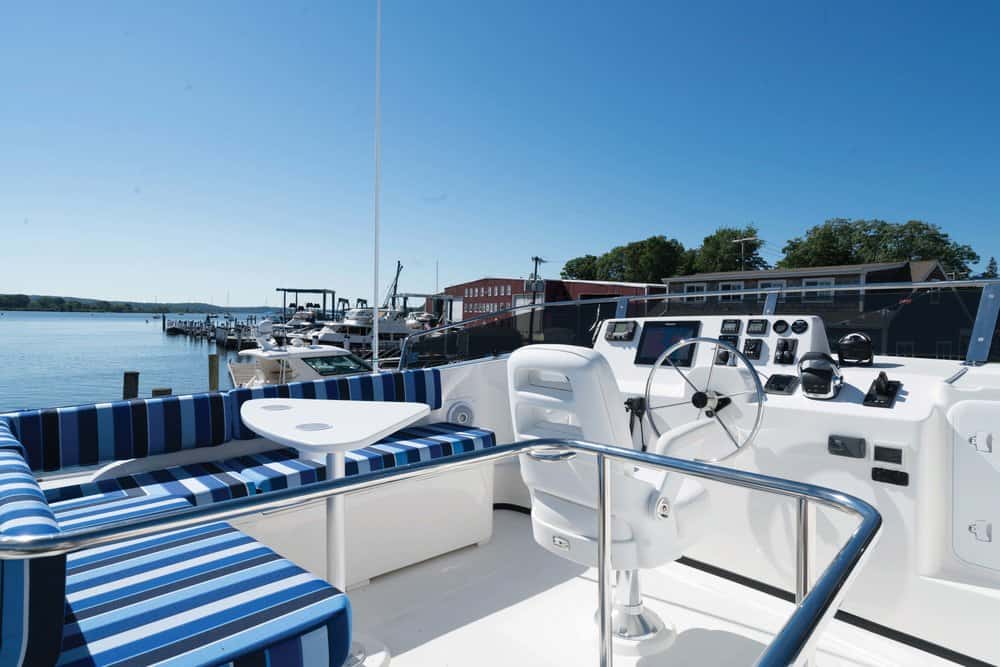
The pilothouse offers single or twin helm chairs with a three-panel array for large-screen electronic displays at the helm, plus a chart
table to port and a rear-facing seat to starboard with excellent visibility. The latter sits within easy reach of the single-lever throttle/shift lever and the thrusters, making it an easy perch for backing the big hull into a slip. Port and starboard sliding doors provide access to the side decks. A mezzanine settee against the rear pilothouse bulkhead to port provides additional seating underway, and there’s an ingenious folding table in front of it to hold lunch or snacks for the skipper.
From bow to stern below, Nordic Tug’s experienced design team has laid out livable spaces, with high quality cabinetwork and teak or sapele trim. The forward cabin holds an island queen berth with a full head to port, hanging lockers, and storage. Aft of that head is a guest cabin with over/under berths. To starboard is a smaller guest/day head with its own shower, and aft of it, a small nav station/office with space for two at a desk. The saloon offers a U-shaped galley to port with twin upholstered stools at its bar. Aft of them, there is space for a cabinet with flat-screen television and a barrel chair for reading. To starboard is a long, L-shaped settee with table. Plenty of windows make the space bright. The windows and doors are Diamond Sea Glaze safety glass with stout aluminum frames, built and installed to keep weather outside, where it belongs.
The cockpit is spartan, with lazarette storage beneath, space for a couple of folding chairs, and a transom door for access to the stern platform. Port and starboard steps lead forward to the side decks and thence to the foredeck and ground tackle. Inside and out, there seem to be well-shaped rails or grab-handles everywhere one would naturally reach out for support. Thirty-seven years’ experience building and cruising these tugs has helped Nordic’s designers refine the details.
Seaworthy, efficient, comfortable underway and at anchor. Now isn’t this Nordic Tug 44 just the vessel for watching eagles in the Rappahannock around Fones Cliffs, enjoying the fall colors on the Nanticoke between Vienna and Sharptown, or admiring the cypress trees and wild rice marshes on the Chickahominy River near Jamestown? Captain John Smith’s Trail (www.smithtrail.net) is waiting for you.
List price for our test boat was $844,688. For more information, contact Bill Boyer at Wilde Yacht Sales in Rock Hall, Md., 443-480-5960, www.wildeyachts.com or visit www.nordictugs.com.

